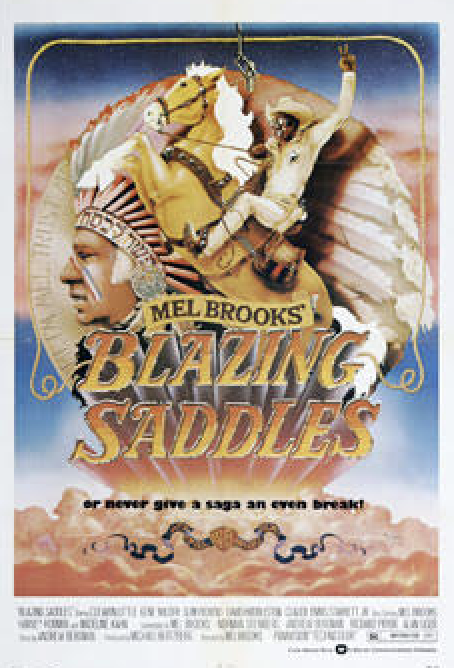Emmy, Grammy, Oscar, and Tony Award-winning actor, director, composer, and comedian, Mel Brooks (born Melvin James Kaminsky) turns 97 today . . .
(Can Humor be (simultaneously) both self-deprecating and medicinal? No, Mel is certainly not a snake, although he might have been somewhat of a ‘Caducous’ — ‘time will tell’).
Please have a close look at the beadwork on the Indian’s war bonnet:
“Kosher l’Pesach”

Blazing Saddles / Notes:
- Brooks appears in three supporting roles: Governor William J. Le Petomane, a Yiddish-speaking Native American chief, and “a aviator/director” in line to help invade Rock Ridge (a nod to Howard Hughes); he also dubs lines for one of Lili Von Shtupp’s backing troupe and a cranky moviegoer.
- Upon release, Mongo vaguely informs Bart of Lamarr’s connection to the railroad, so Bart and Jim visit the railroad worksite and discover from Bart’s best friend Charlie that the railway is planned to go through Rock Ridge. Taggart and his men arrive to kill Bart, but Jim outshoots them and forces their retreat. Lamarr, furious that his schemes have backfired, recruits an army of thugs, including common criminals, motorcycle gangsters, Ku Klux Klansmen, Nazis and Methodists.
- East of Rock Ridge, Bart introduces the white townspeople to the Black, Chinese and Irish railroad workers who have all agreed to help them in exchange for acceptance by the community, and explains his plan to defeat Lamarr’s army. They labor all night to build a perfect copy of the town as a diversion. When Bart realizes it will not fool the villains, the townsfolk construct copies of themselves.
- Again . . . can Humor be (simultaneously) both self-deprecating and medicinal?
___________
In our double parashah / this week: Snakes that heal? Quite the turnaround.
Moses is told to make a model of a serpent, which, when looked upon, heals those who were bitten:
Numbers 21:8 Then YHWH said to Moses, “Make a Snake figure and mount it on a standard. And if anyone who is bitten looks at it, he shall recover.” 21:9 Moses made a copper serpent and mounted it on a standard; and when anyone was bitten by a serpent, he would look at the copper serpent and become healed.
What is this? Perhaps ‘Sympathetic Magic’ where one uses a symbolic model of an object to affect what happens to the real object. Could this be a model (used here) to protect or in this case to heal the Israelites from the venom of the real snakes that this object is meant to represent?
Parallels — for consideration . . .
a) The story in 1 Samuel 6 concerning the עפלים/טְחֹרִים, “hemorrhoids/tumors,” is another example of sympathetic magic. The Philistines make golden models of the tumors (also referred to as Hemroids) that afflicted them upon seizing the Ark of the Covenant and send them back with the ark as a way of removing the affliction from their community. The assumption is that removing the models or images of the tumors removes the tumors themselves. This is admittedly a very different technique than the one employed in our “Seraphim / Snakes” story in Numbers where looking at the image cures the sufferers, but they both involve creating an image of the problem as a way of curing the patient, they seem related.
b). This may have been how the blood on the doorposts of the Israelite homes during the original Passover was understood: blood, symbolizing the death of the sacrificial lamb, wards off the angel of death.
